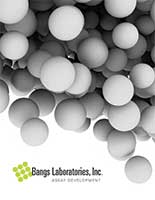
Microspheres offer a highly convenient and flexible system for test and assay reagent development. Many different types of spheres are available to address the diverse and evolving needs of research and commercial aims – polymer, silica, and magnetic, with different surface chemistries in a range of sizes. Beads offer a large specific surface area for binding, permit efficient capture and isolation of target, and they are highly amenable to automation and miniaturization. See our TechNote on Microsphere Selection for tips on choosing beads for different test and assay formats. Please check out our Microsphere Reagent Development Guide, an overview of products that we manufacture for IVD test / assay development, and considerations for products selection and handling,
| Test / Assay Format | Bead Size | Bead Type | Coating Strategy | Detection Strategy |
Doc. |
|---|---|---|---|---|---|
| Turbidimetric | 50nm – 500nm | Undyed- (plain, COOH) | Covalent | Turbidimetry | TN304 |
| Magnetic Chemiluminescence | 1 - 5 µm | ProMag® HP | Covalent | Luminescence | PDS 743 |
| Flow cytometric | 2µm – 15µm | QuantumPlex™ QuantumPlex™M | Covalent or streptavidin / biotin | Flow cytometer | PDS 250, PDS 235 |
| Bead “ELISA” | 1- 3 µm | ProMag®, ProMag® HP | Covalent | Spectrophotometer | TN301 |
| Lateral Flow | 0.1µm – 0.4µm | Dyed, Europium Chelate | Covalent or adsorption | Visual or Automated Reader | TN303 |
| Lateral Flow – Boulders in the Stream | 0.1µm – 0.4µm mobile phase, ~2µm – 3µm capture phase | Dyed (visible) mobile phase, Undyed capture beads- (plain, COOH) | Covalent or adsorption | Visual | TN303 |
| Dipstick | 0.1µm – 0.4µm | Dyed (visible) | Covalent or adsorption | Visual | TN303 |
| Latex Agglutination Test (LAT) | 0.2µm – 1.0µm | Undyed- (plain, COOH) or visibly dyed | Covalent or adsorption | Visual | TN301, TN303 |
Related Literature
Guides
Turbidimetric Assays
Chemiluminescence Assays
TN 303: Lateral Flow Tests
TN 304: Light-Scattering Assays
Products
TN 100: Polymer Microspheres
TN 102A: Magnetic Particle Product Lines
TN 103: Fluorescent / Dyed Microspheres
TN 104: Silica Microspheres
PDS 743: ProMag HP
PDS 702: Silica Microspheres
PDS 717: Dyed Microspheres
PDS 731: Fluorescent Microspheres
PDS 732: Polymer Microspheres
PDS 741: Europium chelate
Accessory Reagents Brochure
Magnetic Particles for Assay Development Brochure
Magnetic Particle Matrix
TN 201A: Microsphere Selection
TN 202: Microsphere Aggregation
TN 203: Washing Microspheres
PDS AA022: Vivaspin® Ulrafiltration Device
PDS 699: Tube Rotator
Centrifugation Chart
Coating
TN 203A: Dry and Re-Suspending Microspheres
TN 204: Adsorption to Microspheres
TN 205: Covalent Coupling
PolyLink Protein Coupling Kit Brochure
For more information, see our entire library in Tech Support.


